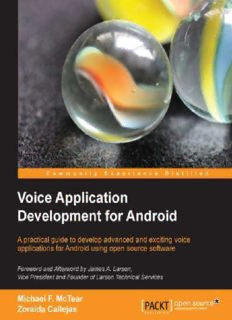
Most books are stored in the elastic cloud where traffic is expensive. For this reason, we have a limit on daily download.
Voice Application Development for Android Table of Contents Voice Application Development for Android Credits Foreword About the Authors Acknowledgement About the Reviewers www.PacktPub.com Support files, eBooks, discount offers and more Why Subscribe? Free Access for Packt account holders Preface What this book covers What you need for this book Who this book is for Conventions Reader feedback Customer support Downloading the example code Web page for the book Errata Piracy Questions 1. Speech on Android Devices Using speech on an Android device Speech-to-text Text-to-speech Voice Search Android Voice Actions Virtual Personal Assistants Designing and developing a speech app Why Google speech? What is needed to create a Virtual Personal Assistant? Summary 2. Text-to-Speech Synthesis Introducing text-to-speech synthesis The technology of text-to-speech synthesis Using pre-recorded speech instead of TTS Using Google text-to-speech synthesis Starting the TTS engine Developing applications with Google TTS TTSWithLib app – Reading user input TTSReadFile app – Reading a file out loud Summary 3. Speech Recognition The technology of speech recognition Using Google speech recognition Developing applications with the Google speech recognition API ASRWithIntent app ASRWithLib app Summary 4. Simple Voice Interactions Voice interactions VoiceSearch app VoiceLaunch app VoiceSearchConfirmation app Summary 5. Form-filling Dialogs Form-filling dialogs Implementing form-filling dialogs Threading XMLLib FormFillLib VXMLParser DialogInterpreter MusicBrain app Summary 6. Grammars for Dialog Grammars for speech recognition and natural language understanding NLU with hand-crafted grammars Statistical NLU NLULib Processing XML grammars Processing statistical grammars The GrammarTest app Summary 7. Multilingual and Multimodal Dialogs Multilinguality Multimodality Summary 8. Dialogs with Virtual Personal Assistants The technology of VPA Determining the user's intention Making an appropriate response Pandorabots AIML Using oob tag to add additional functions The VPALib library Creating a Pandorabot Sample VPAs – Jack, Derek, and Stacy Alternative approaches Summary 9. Taking it Further Developing a more advanced Virtual Personal Assistant Summary A. Afterword Index Voice Application Development for Android Voice Application Development for Android Copyright © 2013 Packt Publishing All rights reserved. No part of this book may be reproduced, stored in a retrieval system, or transmitted in any form or by any means, without the prior written permission of the publisher, except in the case of brief quotations embedded in critical articles or reviews. Every effort has been made in the preparation of this book to ensure the accuracy of the information presented. However, the information contained in this book is sold without warranty, either express or implied. Neither the authors, nor Packt Publishing, and its dealers and distributors will be held liable for any damages caused or alleged to be caused directly or indirectly by this book. Packt Publishing has endeavored to provide trademark information about all of the companies and products mentioned in this book by the appropriate use of capitals. However, Packt Publishing cannot guarantee the accuracy of this information. First published: November 2013 Production Reference: 2041213 Published by Packt Publishing Ltd. Livery Place 35 Livery Street Birmingham B3 2PB, UK. ISBN 978-1-78328-529-7 www.packtpub.com Cover Image by Aniket Sawant (<[email protected]>) Credits Authors Michael F. McTear Zoraida Callejas Reviewers Deborah A. Dahl Greg Milette Acquisition Editor Rebecca Youe Commissioning Editor Amit Ghodake Technical Editors Aparna Chand Nadeem N. Bagban Project Coordinator Michelle Quadros Proofreader Hardip Sidhu Indexer Mehreen Deshmukh Graphics Ronak Dhruv Production Coordinator Aparna Bhagat Cover Work Aparna Bhagat Foreword There are many reasons why users need to speak and listen to mobile devices. We spend the first couple of years of our lives learning how to speak and listen to other people, so it is natural that we should be able to speak and listen to our mobile devices. As mobiles become smaller, the space available for physical keypads shrinks, making more difficult to use. Wearable devices such as Google Glass and smart watches don't have physical keypads. Speaking and listening is becoming a major means of interaction with mobile devices. Eventually computers with microphones and speakers will be embedded into our home environment, eliminating the need for remote controls and handheld device. Speaking and listening will become the major form of communication with home appliances such as TVs, environmental controls, home security, coffee makers, ovens, and refrigerators. When we perform tasks that require the use of our eyes and hands, we need speech technologies. Speech is the only practical way for interacting with an Android computer while driving a car or operating complex machinery. Holding and using a mobile device while driving is illegal in some places. Siri and other intelligent agents enable mobile users to speak a search query. While these systems require sophisticated artificial intelligence and natural language techniques which are complex and time consuming to implement, they demonstrate the use of speech technologies that enable users to search for information. Guides for "self-help" tasks requiring both hands and eyes present big opportunities for Android applications. Soon we will have electronic guides that speak and listen to help us assemble, troubleshoot, repair, fine-tune, and use equipment of all kinds. What's causing the strange sound in my car's engine? Why won't my television turn on? How do I adjust the air conditioner to cool the house? How do I fix a paper jam in my printer? Printed instructions, user guides, and manuals may be difficult to locate and difficult to read while your eyes are examining and your hands are manipulating the equipment. Let a speech-enabled application talk you through the process, step-by-step. These self-help applications replace user documentation for almost any product. Rather than hunting for the appropriate paperwork, just download the latest
Description:
A practical guide to develop advanced and exciting voice applications for Android using open source software Overview A comprehensive guide containing all the best practices for voice application development for Android Progress quickly from basic apps to more advanced topics Written in an easy-to-f